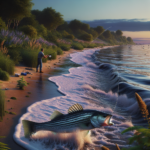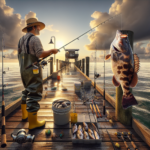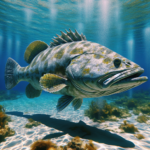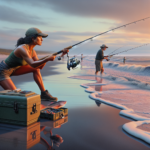Shore Fishing for Striped Bass in Massachusetts’ Coastal Waters

Introduction
Did you know that Massachusetts’ coastal waters are home to one of the most sought-after game fish in North America, the striped bass? Whether you’re a seasoned angler or a novice looking to try your hand at shore fishing, Massachusetts offers a wealth of opportunities to catch this prized species. This article will guide you through the essentials of shore fishing for striped bass in Massachusetts, covering everything from the best fishing techniques and gear to top fishing spots and seasonal considerations.
Why does this matter? For many anglers, catching a striped bass is a thrilling experience that combines skill, patience, and a bit of luck. Understanding the best practices and locations can significantly increase your chances of success, making your fishing trips more enjoyable and rewarding.
Background/Context
Historical or Cultural Significance
Striped bass, also known as “stripers,” have a long history in Massachusetts. Native to the Atlantic coast, these fish have been a staple for both commercial and recreational fishing for centuries. The striped bass fishery has seen its ups and downs, with populations fluctuating due to overfishing and environmental changes. However, thanks to conservation efforts, the striped bass population has rebounded, making Massachusetts a prime location for shore fishing.
Geographical Overview
Massachusetts boasts a diverse coastline, from the rocky shores of Cape Ann to the sandy beaches of Cape Cod. The state’s coastal waters are influenced by the Atlantic Ocean, providing a rich ecosystem that supports a variety of marine life, including striped bass. The climate varies from cold winters to warm summers, affecting the behavior and migration patterns of the fish.
Key Points/Details
Fishing Techniques
Technique Overview
When it comes to shore fishing for striped bass, several techniques can be effective. These include surfcasting, fly fishing, and using live bait. Surfcasting involves casting a baited line from the shore into the surf, while fly fishing uses artificial flies to mimic the fish’s natural prey. Live bait fishing, on the other hand, involves using live fish or other organisms to attract striped bass.
When and Where to Use
Surfcasting is particularly effective on sandy beaches and rocky shores, especially during high tide when striped bass come closer to shore to feed. Fly fishing is best suited for estuaries and tidal rivers where the water is calmer. Live bait fishing can be used in various locations, including piers, jetties, and beaches.
Recommended Gear
- Rods: A medium to heavy-action rod, around 9-12 feet long, is ideal for surfcasting. For fly fishing, a 9-foot rod with a 9-weight line is recommended.
- Reels: A sturdy spinning reel with a high line capacity for surfcasting. For fly fishing, a large arbor reel with a good drag system is essential.
- Lines: Braided line for surfcasting due to its strength and sensitivity. For fly fishing, a floating line with a sinking tip works well.
- Bait/Lures: Popular choices include soft plastics, topwater plugs, and live eels or bunker.
Species Information
Species Overview
Striped bass are known for their distinctive dark stripes running along their silvery bodies. They are migratory fish, spending their summers in the cooler waters of the North Atlantic and migrating south during the winter. Striped bass prefer coastal waters with plenty of structure, such as rocks, reefs, and submerged vegetation, where they can ambush their prey.
Best Practices
To successfully catch striped bass, it’s crucial to understand their feeding habits and preferred habitats. Early morning and late evening are prime times for fishing, as striped bass are more active during these periods. Using a variety of lures and baits can also increase your chances of success. Pay attention to local fishing reports and talk to other anglers to stay informed about current conditions and hotspots.
Location Information
Top Fishing Spots
- Cape Cod Canal: Known for its strong currents and abundant striped bass population, the Cape Cod Canal is a favorite among anglers.
- Plum Island: This barrier island offers excellent shore fishing opportunities, especially during the spring and fall migrations.
- Boston Harbor: With its numerous piers and jetties, Boston Harbor provides easy access to productive fishing spots.
- Monomoy Island: Located off the coast of Chatham, Monomoy Island is a prime location for fly fishing and surfcasting.
Regulations and Licenses
Before you start fishing, make sure you are aware of the local regulations and licensing requirements. In Massachusetts, anglers aged 15 and older need a recreational saltwater fishing permit. There are also specific regulations regarding the size and number of striped bass you can keep. As of 2023, the minimum size limit is 28 inches, and the daily bag limit is one fish per angler. Always check the latest regulations from the Massachusetts Division of Marine Fisheries before heading out.
Seasonal Considerations
Seasonal Variations
Fishing conditions in Massachusetts change throughout the year, affecting the behavior and availability of striped bass. Spring and fall are the best seasons for shore fishing, as striped bass migrate along the coast during these times. Summer can also be productive, especially during early morning and late evening when the water is cooler. Winter fishing is less common, as striped bass migrate south to warmer waters.
Best Times to Fish
The optimal times for fishing are during the spring and fall migrations, typically from April to June and September to November. Tides also play a crucial role, with high tide and the hours surrounding it being the most productive times to fish. Pay attention to local tide charts and plan your trips accordingly.
Events and Tournaments
Event Overview
Massachusetts hosts several fishing events and tournaments throughout the year, providing opportunities for anglers to test their skills and compete for prizes. Notable events include the Martha’s Vineyard Striped Bass and Bluefish Derby, which takes place in the fall, and the Cape Cod Canal Striper Classic, held in the summer.
Preparation Tips
To prepare for a fishing tournament, make sure your gear is in top condition and practice your casting and retrieval techniques. Study the tournament rules and regulations, and scout the fishing area in advance to identify potential hotspots. Bring plenty of bait and lures, and be prepared for changing weather conditions.
Tips and Best Practices
General Tips
- Stay Mobile: Don’t stay in one spot for too long if you’re not getting bites. Move around to find where the fish are feeding.
- Use Fresh Bait: Fresh bait is more attractive to striped bass and increases your chances of a successful catch.
- Pay Attention to Birds: Seagulls and other birds diving into the water can indicate the presence of baitfish and, consequently, striped bass.
Avoid Common Mistakes
- Ignoring Tides: Fishing at the wrong tide can significantly reduce your chances of success. Always check tide charts before heading out.
- Using the Wrong Gear: Make sure your gear is suitable for the type of fishing you’re doing. Using a light rod for surfcasting, for example, can lead to lost fish and broken equipment.
- Overlooking Local Knowledge: Local anglers often have valuable insights into current conditions and hotspots. Don’t hesitate to ask for advice.
Advanced Techniques
- Match the Hatch: Use lures and baits that mimic the local prey species to increase your chances of attracting striped bass.
- Use a Fish Finder: A portable fish finder can help you locate schools of striped bass and identify underwater structures where they might be hiding.
- Experiment with Retrieval Speeds: Varying your retrieval speed can trigger strikes from striped bass that might be hesitant to bite.
Gear and Equipment Recommendations
Essential Gear
- Medium to heavy-action rod (9-12 feet for surfcasting)
- Sturdy spinning reel with high line capacity
- Braided line for strength and sensitivity
- Variety of lures (soft plastics, topwater plugs)
- Live bait (eels, bunker)
Optional Gear/Upgrades
- Portable fish finder
- Waders for fishing in shallow waters
- Fishing cart for transporting gear
- High-quality polarized sunglasses to reduce glare and see underwater structures
Where to Buy or Rent
Local tackle shops such as Red Top Sporting Goods in Buzzards Bay and Goose Hummock Shop in Orleans offer a wide range of fishing gear and equipment. Online retailers like Bass Pro Shops and Cabela’s also provide extensive selections and convenient shipping options.
Safety and Conservation
Safety Tips
- Check Weather Conditions: Always check the weather forecast before heading out and be prepared for sudden changes.
- Wear a Life Jacket: If you’re fishing from a jetty or pier, wearing a life jacket can be a lifesaver in case of an accidental fall.
- Stay Hydrated: Bring plenty of water, especially during hot summer days, to avoid dehydration.
Conservation Practices
- Catch and Release: Practice catch and release to help maintain healthy fish populations. Use barbless hooks to minimize injury to the fish.
- Respect Local Wildlife: Avoid disturbing nesting birds and other wildlife while fishing.
- Follow Regulations: Adhere to local fishing regulations, including size and bag limits, to ensure sustainable fishing practices.
Planning Your Trip
Accommodations
There are numerous lodging options near popular fishing spots in Massachusetts. Cape Cod offers a range of accommodations, from budget-friendly motels to luxury resorts. Plum Island has several charming bed and breakfasts, while Boston Harbor provides easy access to hotels in the city.
Travel Tips
Massachusetts is easily accessible by car, with major highways connecting the state to neighboring regions. If you’re flying in, Boston Logan International Airport is the primary gateway. Renting a car is recommended for exploring different fishing spots along the coast. Public transportation options, such as buses and trains, are also available for getting around.
Additional Activities
Massachusetts offers plenty of activities for non-fishing time. Explore the historic sites of Boston, enjoy the scenic beauty of Cape Cod National Seashore, or visit the charming towns of Martha’s Vineyard and Nantucket. Whale watching tours, hiking trails, and local seafood restaurants are also popular attractions.
Frequently Asked Questions (FAQs)
What is the best time of year to fish for striped bass in Massachusetts?
The best times are during the spring and fall migrations, typically from April to June and September to November.
Do I need a fishing license to fish for striped bass in Massachusetts?
Yes, anglers aged 15 and older need a recreational saltwater fishing permit.
What is the minimum size limit for keeping striped bass?
The minimum size limit is 28 inches, and the daily bag limit is one fish per angler.
What gear do I need for shore fishing for striped bass?
A medium to heavy-action rod, sturdy spinning reel, braided line, and a variety of lures and live bait are essential.
Conclusion
Shore fishing for striped bass in Massachusetts’ coastal waters offers an exciting and rewarding experience for anglers of all skill levels. By understanding the best techniques, gear, and locations, you can increase your chances of success and enjoy the thrill of catching this prized game fish. Remember to follow local regulations, practice conservation, and stay safe while fishing. So grab your gear, head to the coast, and get ready for an unforgettable fishing adventure!




